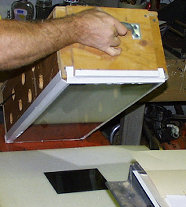The Double Exposure Technique for SOLARPLATE Printmaking
by Pauline Muir
 Using a double exposure with an aquatint screen allows you to retain extensive areas of deep rich black in an intaglio image. The technique eliminates the problem of the polymer washing away, creating an open area which will not pickup ink. This is what printmakers call an ‘open bite’in the traditional etching process.
Using a double exposure with an aquatint screen allows you to retain extensive areas of deep rich black in an intaglio image. The technique eliminates the problem of the polymer washing away, creating an open area which will not pickup ink. This is what printmakers call an ‘open bite’in the traditional etching process.
By manipulating exposure times you can vary the depth and richness of blacks in your image and eliminate problems associated with deep grooves holding too much ink, causing bleeding during printing. This technique is particularly useful for drawings using pencil, charcoal,and other materials. Using the double exposure technique with drawings will create a much finer image increasing the tonal range and quality of your print.
Before completing your final plate it is advisable to make some test strips and print them so you can adjust the exposure times if necessary.
First expose the solarplate with the aquatint screen covering it for 1 minute. The aquatint screen has a shiny surface and a less shiny, semi-matt surface. This semi-matt surface is the emulsion side. Make sure you place this emulsion surface of the screen face to face with the plate surface for the first exposure. Remove the screen and expose your positive transparency to the plate for 1 minute. When you have completed the second exposure remove the positive transparency and proceed to develop your plate in water, dry, post expose and print.
To increase the richness of blacks, darken your image, and retain more detail, you can try reducing the times of each exposure. If you have problems with grooves holding too much ink, or there is still too much polymer washing away or you want to lighten your image try increasing exposure times.
Screens are available for purchase through Hampton Editions, Ltd.
Pauline Muir developed the double exposure technique with Solarplate, using a random dot screen which is a refinement of the original process. She is co-author with Dan Welden of the book ‘Print Making in the Sun’. She resides in Adelaide, Australia where she exhibits her work, conducts workshops, writes and makes prints.
